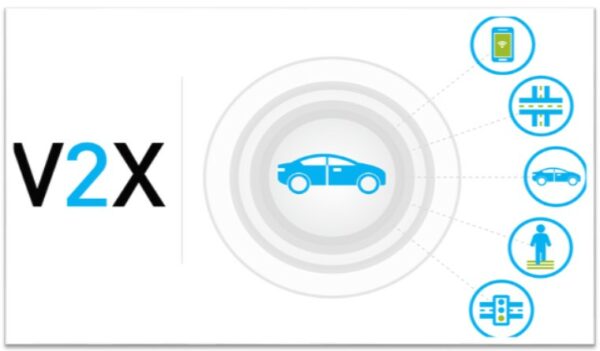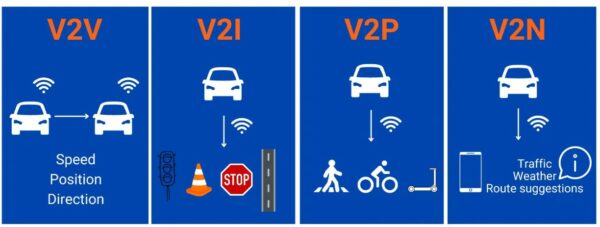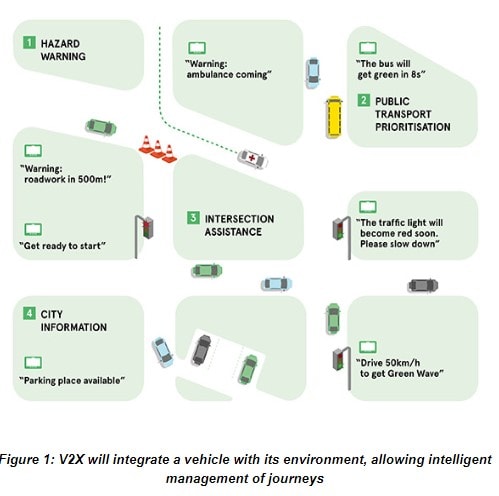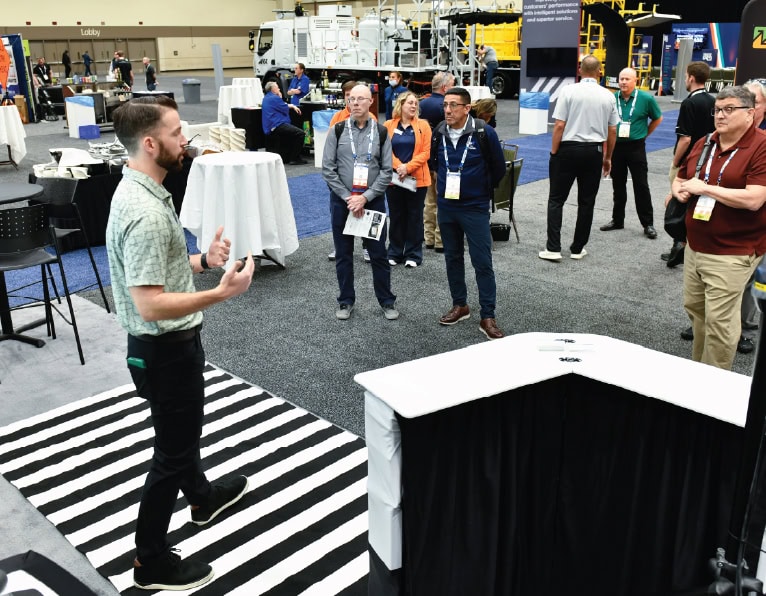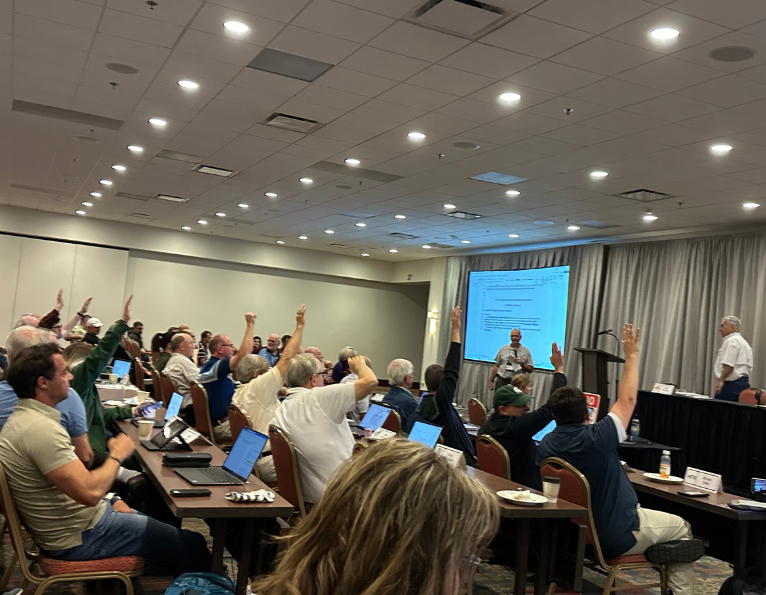V2X deployment plan holds promise for saving motorist, worker lives
By Nagham “Melodie” Matout, ATSSA Innovation & Technical Services Manager

Nagham ‘Melodie’ Matout
The U.S. Department of Transportation’s recent release of a deployment plan for vehicle-to-everything (V2X) technologies holds the potential for broad implications for saving lives on the nation’s roads and improving the safety of roadway workers.
Adding the connectivity available through V2X means work zone information and traffic information could be available in real time, thus helping protect workers, pedestrians, cyclists, motorists and their passengers.
Specifically, the connectivity could be added to widely used temporary traffic control devices, enhancing their ability to help travelers, contractors and transportation agencies.
The U.S. Department of Transportation (USDOT) released “Saving Lives with Connectivity: A Plan to Accelerate V2X Deployment,” on Aug. 16. The plan was designed to outline a vision and path to deployment with the goal of saving lives through connectivity.
“The V2X national plan was made possible through collaborative effort between government, industry and stakeholders,” Federal Highway Administration (FHWA) Administrator Shailen Bhatt said in a statement at the plan’s release. “The plan represents a call to action in providing a framework for all of us to continue to work together toward the same goal of accelerating V2X deployment to save lives on our nation’s roadways.”
National Transportation Safety Board (NTSB) Chair Jennifer Homendy has long advocated for a V2X plan, recognizing the power it could hold for advancing roadway safety.
“This plan is a vital first step towards realizing the full lifesaving potential of this technology, which we’ve supported for decades,” Homendy said when the plan was released. “V2X can reverse the crisis on our roads and fundamentally transform our nation’s transportation landscape—that’s a future worth fighting for.”
Though the plan does not specifically address work zones, understanding the technology from a roadway safety infrastructure perspective makes the implications clear for protecting both the traveling public and roadway workers.
What is Vehicle-to-Everything (V2X)?
Nowadays, most new vehicles are equipped with some form of connectivity via various range-of-communication technologies (e.g., C-V2X over 5.9 GHz, Wi-Fi, Bluetooth, Cellular, Satellite, etc.). This connectivity enables connected vehicles (CVs) to exchange information with other digitally connected sources or devices, allowing the vehicle to “see” and/or “talk” to its surroundings. This type of connectivity and communication is referred to as vehicle-to-everything, or V2X for short. V2X is also known as CV technology.
V2X enables data and information exchange between:
- Vehicles to infrastructure (V2I)
- Vehicles to Vehicles (V2V)
- Vehicles to pedestrians and/or cyclists (V2P)
- Vehicles to Network (V2N)
How Does V2X Work?
V2X communication can leverage data via different sources/devices that are equipped with sensors (e.g., cameras, lidars, radar) and may have the capability to provide telematics data and/or positioning data.
Data from connected devices or sources can be transferred to vehicles, and vice versa, over various types of communication technologies, such as:
- C-V2X over 5.9 GHz (also known as “direct V2X”)
- Network-supported V2X (also known as “Networked V2X”)
Networked V2X uses cellular technology (e.g., Long-Term Evolution (LTE) and 5G networks), falling outside of the 5.9 GHz Band, over the same type of networks that enable other modern connected technologies, such as cell phones.
“A fundamental distinction of networked V2X is that, unlike direct V2X, it requires information to travel through intermediate nodes before reaching its final destination,” according to the ITS America “Beyond 5.9 V2X Deployment Plan” released in August. “Any communication from a vehicle or asset connected through networked V2X must, by definition, first pass through some kind of intermediary network, system, or platform before reaching another vehicle or asset with which it seeks to communicate.”
What are some V2X Applications?
V2X has many safety applications, enabling the communication of critical roadway information to drivers about their surroundings and along their trajectory in real-time and ahead of time. CVs with V2X capabilities would provide alerts to drivers about important visual cues and/or roadway events, such as an upcoming road closure or work zone.
V2X could also provide alerts to drivers about important road elements/events that could be obstructed or beyond a driver’s line of sight. For instance, a V2X alert sent to drivers could provide awareness of workers present in work zones, even during night deployments, when drivers might not expect them. This information is communicated to the driver via in-cabin alerts.
In-cabin alerts serve as an additional prompt for drivers to pay immediate attention and avoid distractions.
What Role Does V2X Play in Enhancing Work Zone Safety?
Through V2X messages, drivers could learn ahead of time about important traffic information such as construction zones, traffic incidents, pre-planned events, adverse weather conditions, road conditions and other relevant roadway events.
Traditionally, transportation agencies have been deploying Portable Changeable Message Signs (PCMS) as an effective strategy to inform drivers going through a work zone about unexpected situations, such as “displaying real time information about conditions ahead and providing information to assist road users in making decisions prior to the point where actions must be taken,” as outlined in the Manual on Uniform Traffic Control Devices (MUCTD)).
Through V2X, adding connectivity to such widely used and effective temporary traffic control devices enhances the capabilities of these devices for the traveling public, contractors, and transportation agencies by:
- Relaying real-time traffic information to the drivers about crashes, road closures and work zones, as well as weather and road conditions, through work zone devices and in-cabin car alerts.
- Having real-time information on the operational status of the traffic control device, such as power levels, locations, etc.
- Assisting data-driven decisions for traffic management within and around a work zone, based on collected data that some of those devices can collect (e.g., traffic patterns, vehicle speeds, etc.)
With distracted driving being a significant crash contribution factor nationwide and worldwide, having connected work zone devices with V2X capabilities, particularly in the presence of an active work zone and/or flaggers, would play a crucial role in enhancing motorist and worker safety.
On one hand, in-cabin alerts would inform drivers about the upcoming work zone, prompting them to slow down, change lanes or take other necessary actions to ensure safety. On the other hand, workers could be alerted of potential intrusions using V2X capabilities that are available with “connected” work zones. This type of communication to the drivers and/or workers is enabled when a connected vehicle goes through a connected work zone that includes connected temporary traffic control devices such as connected arrow boards or connected safety vests, for example.
USDOT National V2X Deployment Plan
The USDOT national V2X deployment plan highlights the department’s commitment to reducing roadway fatalities to zero by implementing V2X technology and emphasizes the importance of cooperation between various stakeholders to accelerate V2X applications.
It includes short-term, medium-term, and long-term goals and milestones related to infrastructure deployments, vehicles, spectrum, interoperability, benefits, and technical assistance. For infrastructure deployments, the plan sets the following goals:
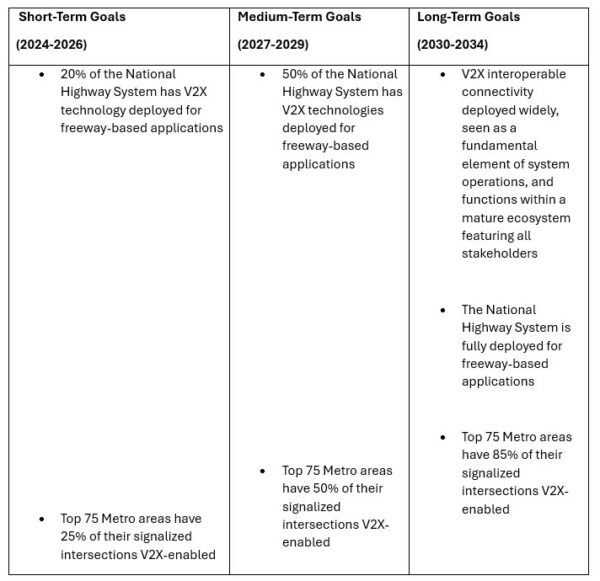
Content courtesy of the U.S. Department of Transportation “Saving Lives with Connectivity: A Plan to Accelerate V2X Deployment” report.
The success of V2X deployments relies on the leadership of transportation agencies and support from OEMS and the private industry to enable the complete V2X ecosystem and overcome its challenges.
The plan is a step in the direction of roadway safety. However, it is important to emphasize that connectivity of work zones and infrastructure is crucial for a complete and integral V2X ecosystem, helping us achieve our common goal as stakeholders of reaching zero deaths.
“This plan will guide the implementation of vehicle-to-everything technologies across the nation and support USDOT’s commitment to pursue a comprehensive approach to reduce the number of roadway fatalities to zero”, USDOT stated in releasing the plan. “The Plan …is focused on road safety, mobility, and efficiency through technology that enables vehicles and wireless devices to communicate with each other and with roadside infrastructure. These technologies can enable a more safe, secure, and efficient transportation system while maintaining privacy and consumer protection and will contribute to the Safe System Approach adopted by the USDOT’s National Roadway Safety Strategy, a comprehensive approach launched in January 2022 to address the crisis of roadway deaths.”
For more information about V2X, check out this ITS America resource, “V2X Decoded: Frequently Asked Questions.”
For more information about Networked V2X, check out this ITS America resource, “Beyond 5.9 V2X Deployment Plan.”
Contact ATSSA Innovation & Technical Services Manager Nagham “Melodie” Matout: nagham.matout@atssa.com.
Published Date
September 4, 2024
Post Type
- News
Topic
- ATSSA News
Related News Articles
July 1, 2025
ATSSA’s 2025 New Products Rollout Report details the latest ideas for protecting workers, motorists and pedestrians
ATSSA’s 2025 New Products Rollout Report details the latest ideas for protecting workers, motorists and pedestrians NPRO entries offer cutting-edge…
June 25, 2025
NCUTCD Midyear Meeting provides update on MUTCD adoption
NCUTCD Midyear Meeting provides update on MUTCD adoption DES MOINES, Iowa – Eight states have completed the process of adopting…
June 18, 2025
ATSSA Worker Protection Toolkit equips leaders for preventing, responding to tragedy
ATSSA Worker Protection Toolkit equips leaders for preventing, responding to tragedy ATSSA’s Worker Protection Toolkit draws on the research and…
